ABS DODGE CHARGER SRT 2015 7.G Owners Manual
[x] Cancel search | Manufacturer: DODGE, Model Year: 2015, Model line: CHARGER SRT, Model: DODGE CHARGER SRT 2015 7.GPages: 595, PDF Size: 16.43 MB
Page 64 of 595
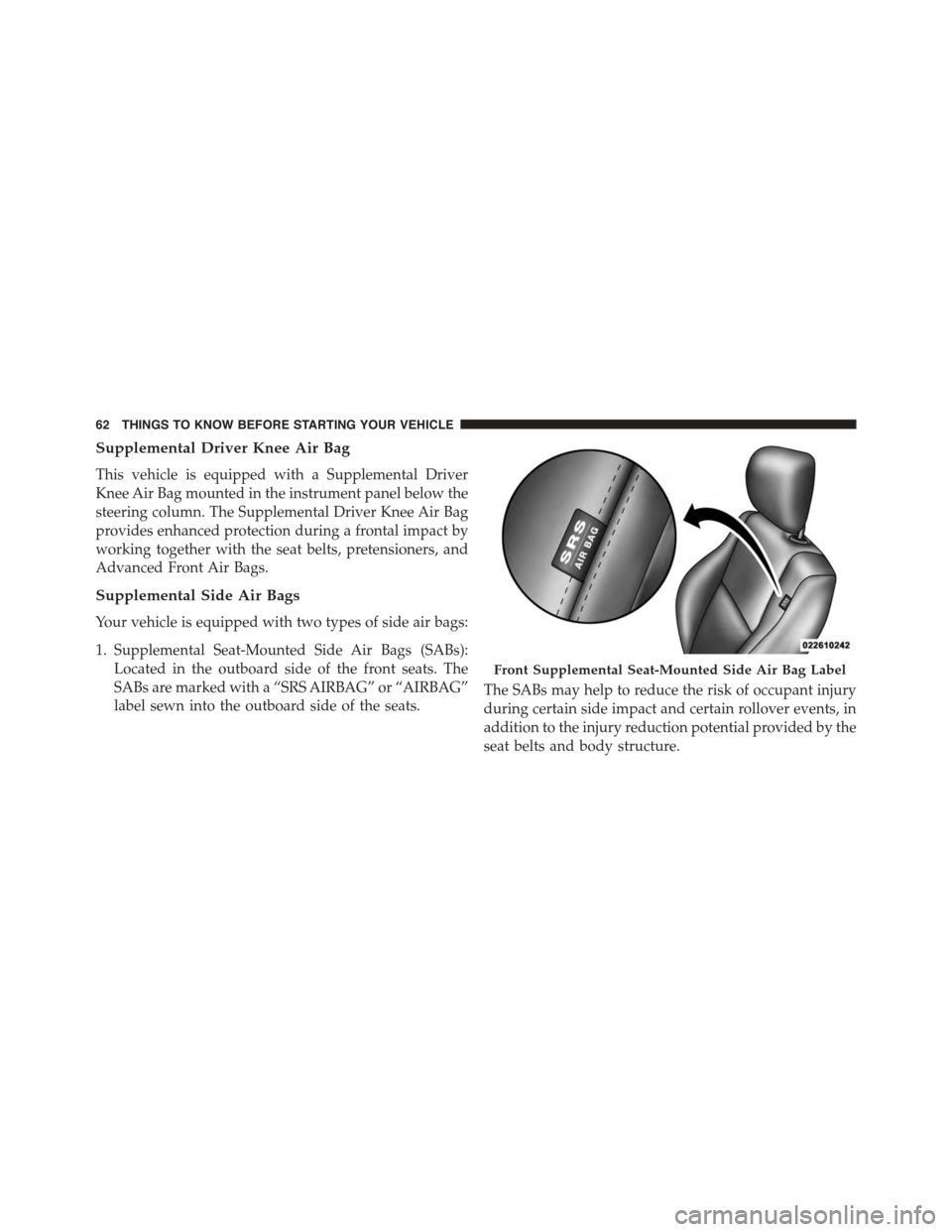
Supplemental Driver Knee Air Bag
This vehicle is equipped with a Supplemental Driver
Knee Air Bag mounted in the instrument panel below the
steering column. The Supplemental Driver Knee Air Bag
provides enhanced protection during a frontal impact by
working together with the seat belts, pretensioners, and
Advanced Front Air Bags.
Supplemental Side Air Bags
Your vehicle is equipped with two types of side air bags:
1. Supplemental Seat-Mounted Side Air Bags (SABs):
Located in the outboard side of the front seats. The
SABs are marked with a “SRS AIRBAG” or “AIRBAG”
label sewn into the outboard side of the seats.
The SABs may help to reduce the risk of occupant injury
during certain side impact and certain rollover events, in
addition to the injury reduction potential provided by the
seat belts and body structure.
Front Supplemental Seat-Mounted Side Air Bag Label
62 THINGS TO KNOW BEFORE STARTING YOUR VEHICLE
Page 67 of 595
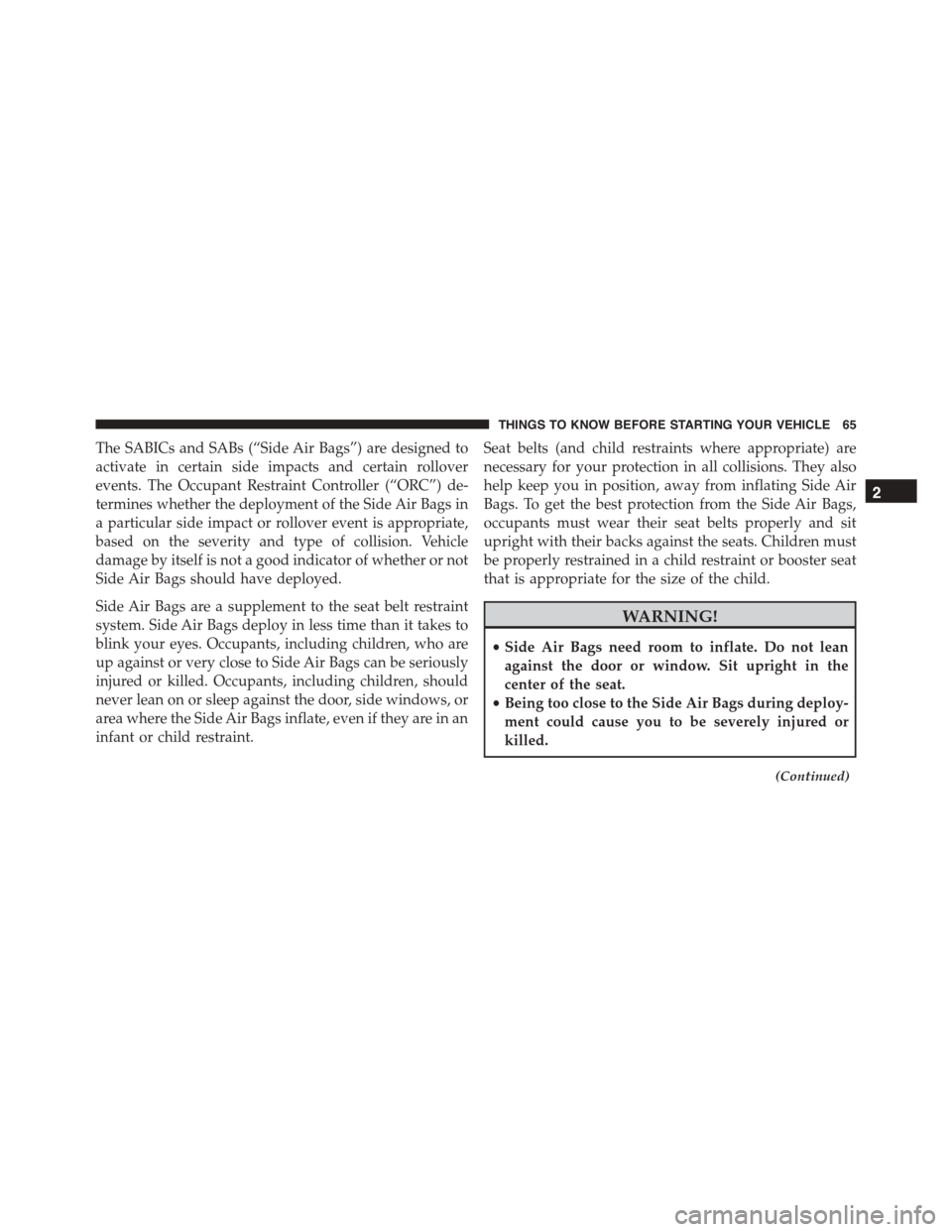
The SABICs and SABs (“Side Air Bags”) are designed to
activate in certain side impacts and certain rollover
events. The Occupant Restraint Controller (“ORC”) de-
termines whether the deployment of the Side Air Bags in
a particular side impact or rollover event is appropriate,
based on the severity and type of collision. Vehicle
damage by itself is not a good indicator of whether or not
Side Air Bags should have deployed.
Side Air Bags are a supplement to the seat belt restraint
system. Side Air Bags deploy in less time than it takes to
blink your eyes. Occupants, including children, who are
up against or very close to Side Air Bags can be seriously
injured or killed. Occupants, including children, should
never lean on or sleep against the door, side windows, or
area where the Side Air Bags inflate, even if they are in an
infant or child restraint.
Seat belts (and child restraints where appropriate) are
necessary for your protection in all collisions. They also
help keep you in position, away from inflating Side Air
Bags. To get the best protection from the Side Air Bags,
occupants must wear their seat belts properly and sit
upright with their backs against the seats. Children must
be properly restrained in a child restraint or booster seat
that is appropriate for the size of the child.
WARNING!
•Side Air Bags need room to inflate. Do not lean
against the door or window. Sit upright in the
center of the seat.
•Being too close to the Side Air Bags during deploy-
ment could cause you to be severely injured or
killed.
(Continued)
2
THINGS TO KNOW BEFORE STARTING YOUR VEHICLE 65
Page 69 of 595
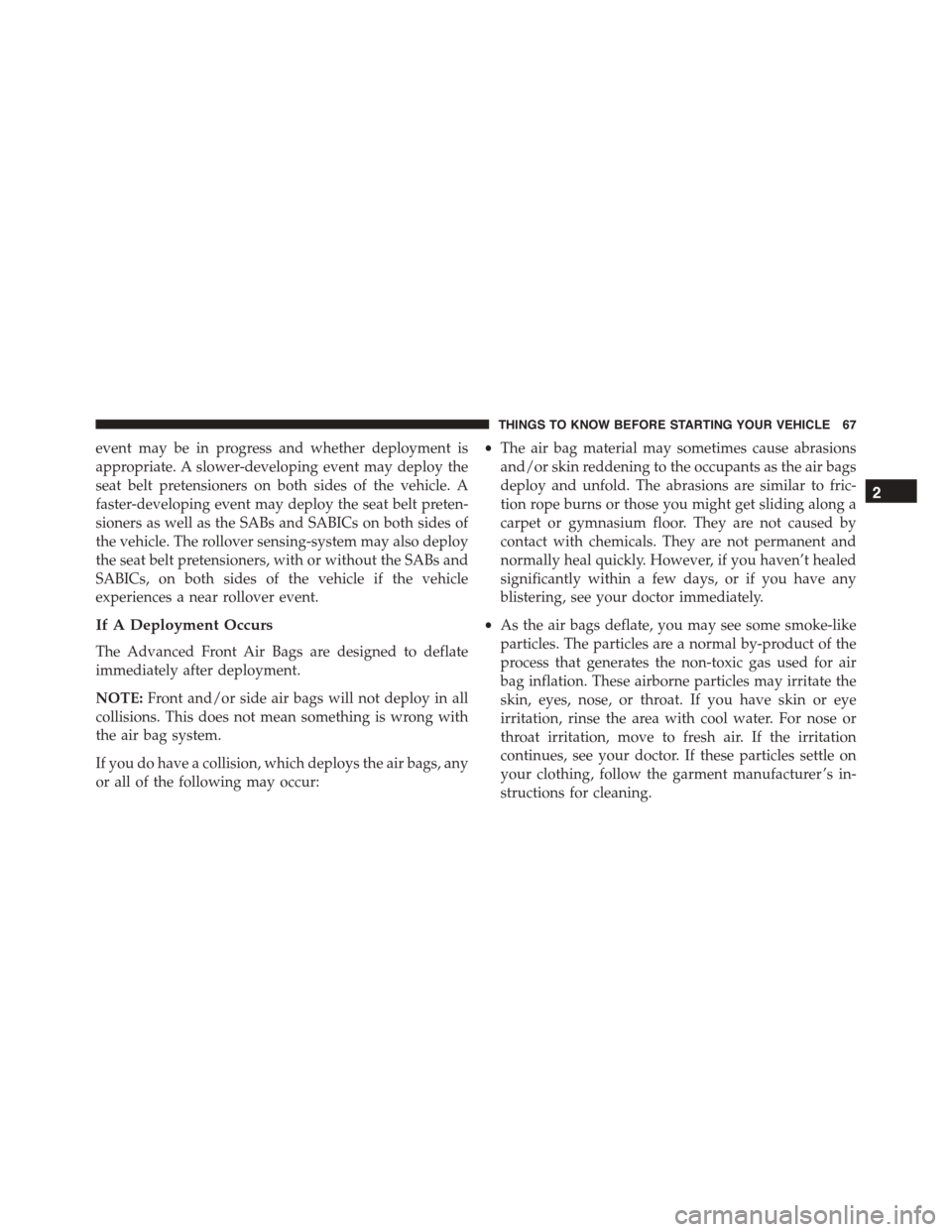
event may be in progress and whether deployment is
appropriate. A slower-developing event may deploy the
seat belt pretensioners on both sides of the vehicle. A
faster-developing event may deploy the seat belt preten-
sioners as well as the SABs and SABICs on both sides of
the vehicle. The rollover sensing-system may also deploy
the seat belt pretensioners, with or without the SABs and
SABICs, on both sides of the vehicle if the vehicle
experiences a near rollover event.
If A Deployment Occurs
The Advanced Front Air Bags are designed to deflate
immediately after deployment.
NOTE:Front and/or side air bags will not deploy in all
collisions. This does not mean something is wrong with
the air bag system.
If you do have a collision, which deploys the air bags, any
or all of the following may occur:
•The air bag material may sometimes cause abrasions
and/or skin reddening to the occupants as the air bags
deploy and unfold. The abrasions are similar to fric-
tion rope burns or those you might get sliding along a
carpet or gymnasium floor. They are not caused by
contact with chemicals. They are not permanent and
normally heal quickly. However, if you haven’t healed
significantly within a few days, or if you have any
blistering, see your doctor immediately.
•As the air bags deflate, you may see some smoke-like
particles. The particles are a normal by-product of the
process that generates the non-toxic gas used for air
bag inflation. These airborne particles may irritate the
skin, eyes, nose, or throat. If you have skin or eye
irritation, rinse the area with cool water. For nose or
throat irritation, move to fresh air. If the irritation
continues, see your doctor. If these particles settle on
your clothing, follow the garment manufacturer ’s in-
structions for cleaning.
2
THINGS TO KNOW BEFORE STARTING YOUR VEHICLE 67
Page 177 of 595
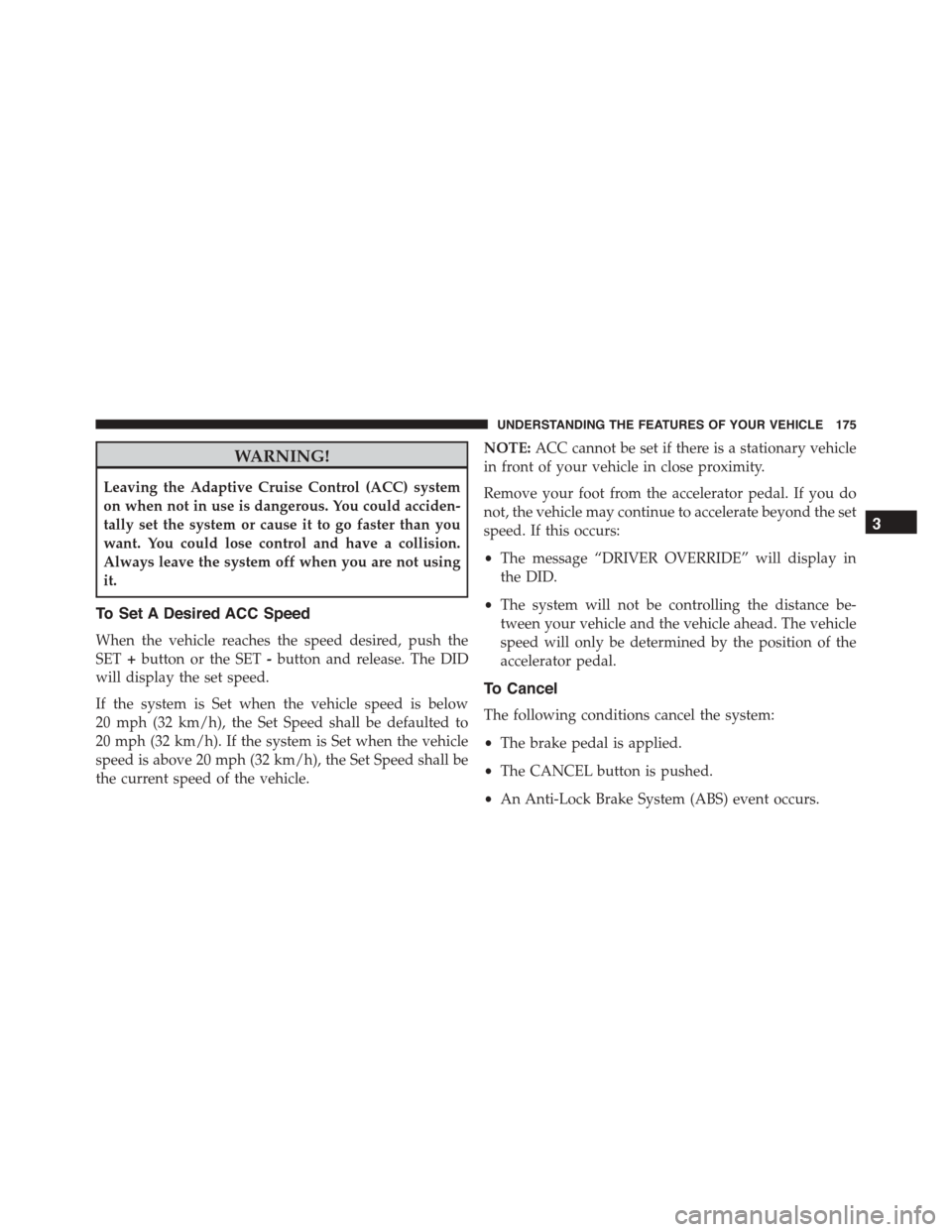
WARNING!
Leaving the Adaptive Cruise Control (ACC) system
on when not in use is dangerous. You could acciden-
tally set the system or cause it to go faster than you
want. You could lose control and have a collision.
Always leave the system off when you are not using
it.
To Set A Desired ACC Speed
When the vehicle reaches the speed desired, push the
SET+button or the SET-button and release. The DID
will display the set speed.
If the system is Set when the vehicle speed is below
20 mph (32 km/h), the Set Speed shall be defaulted to
20 mph (32 km/h). If the system is Set when the vehicle
speed is above 20 mph (32 km/h), the Set Speed shall be
the current speed of the vehicle.
NOTE:ACC cannot be set if there is a stationary vehicle
in front of your vehicle in close proximity.
Remove your foot from the accelerator pedal. If you do
not, the vehicle may continue to accelerate beyond the set
speed. If this occurs:
•The message “DRIVER OVERRIDE” will display in
the DID.
•The system will not be controlling the distance be-
tween your vehicle and the vehicle ahead. The vehicle
speed will only be determined by the position of the
accelerator pedal.
To Cancel
The following conditions cancel the system:
•The brake pedal is applied.
•The CANCEL button is pushed.
•An Anti-Lock Brake System (ABS) event occurs.
3
UNDERSTANDING THE FEATURES OF YOUR VEHICLE 175
Page 243 of 595
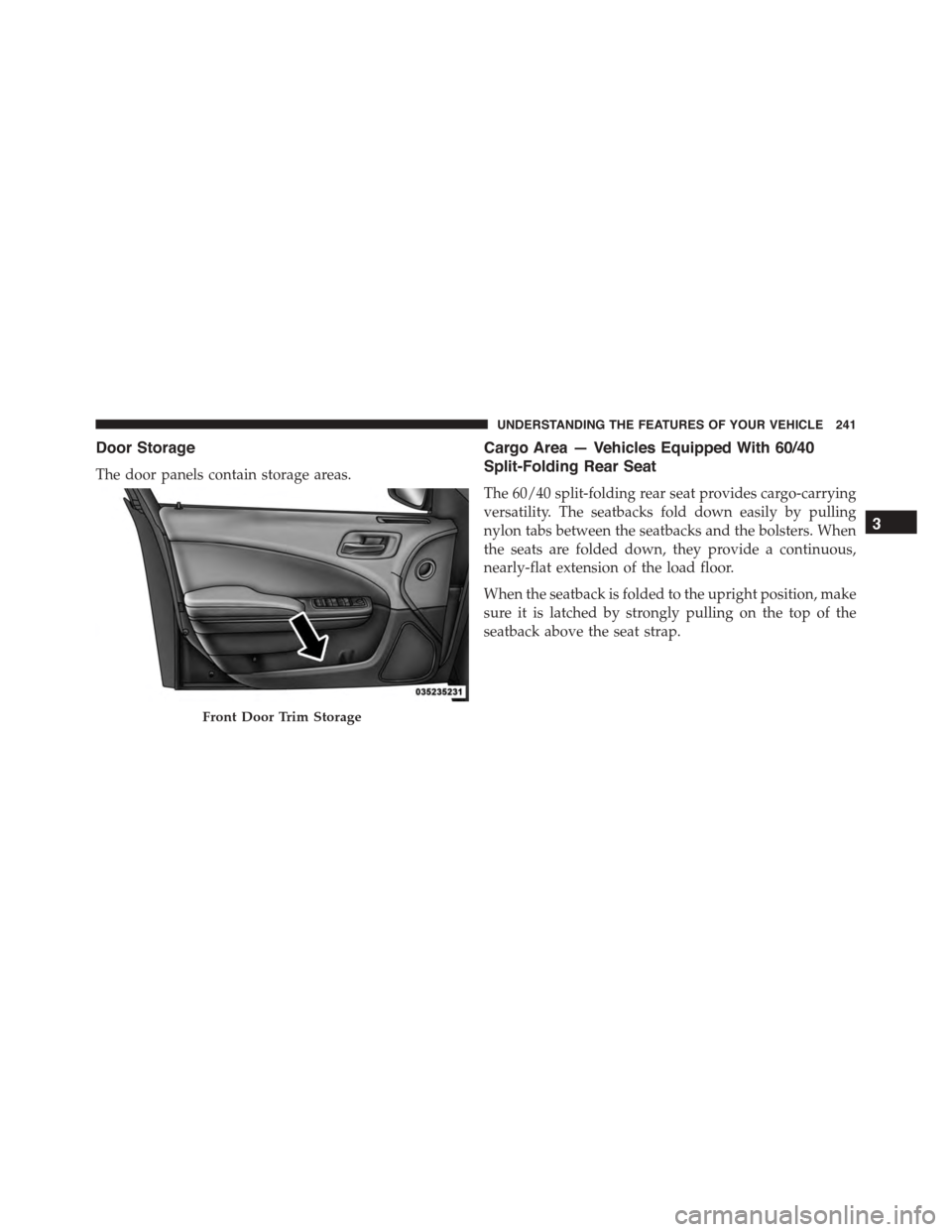
Door Storage
The door panels contain storage areas.
Cargo Area — Vehicles Equipped With 60/40
Split-Folding Rear Seat
The 60/40 split-folding rear seat provides cargo-carrying
versatility. The seatbacks fold down easily by pulling
nylon tabs between the seatbacks and the bolsters. When
the seats are folded down, they provide a continuous,
nearly-flat extension of the load floor.
When the seatback is folded to the upright position, make
sure it is latched by strongly pulling on the top of the
seatback above the seat strap.
Front Door Trim Storage
3
UNDERSTANDING THE FEATURES OF YOUR VEHICLE 241
Page 254 of 595
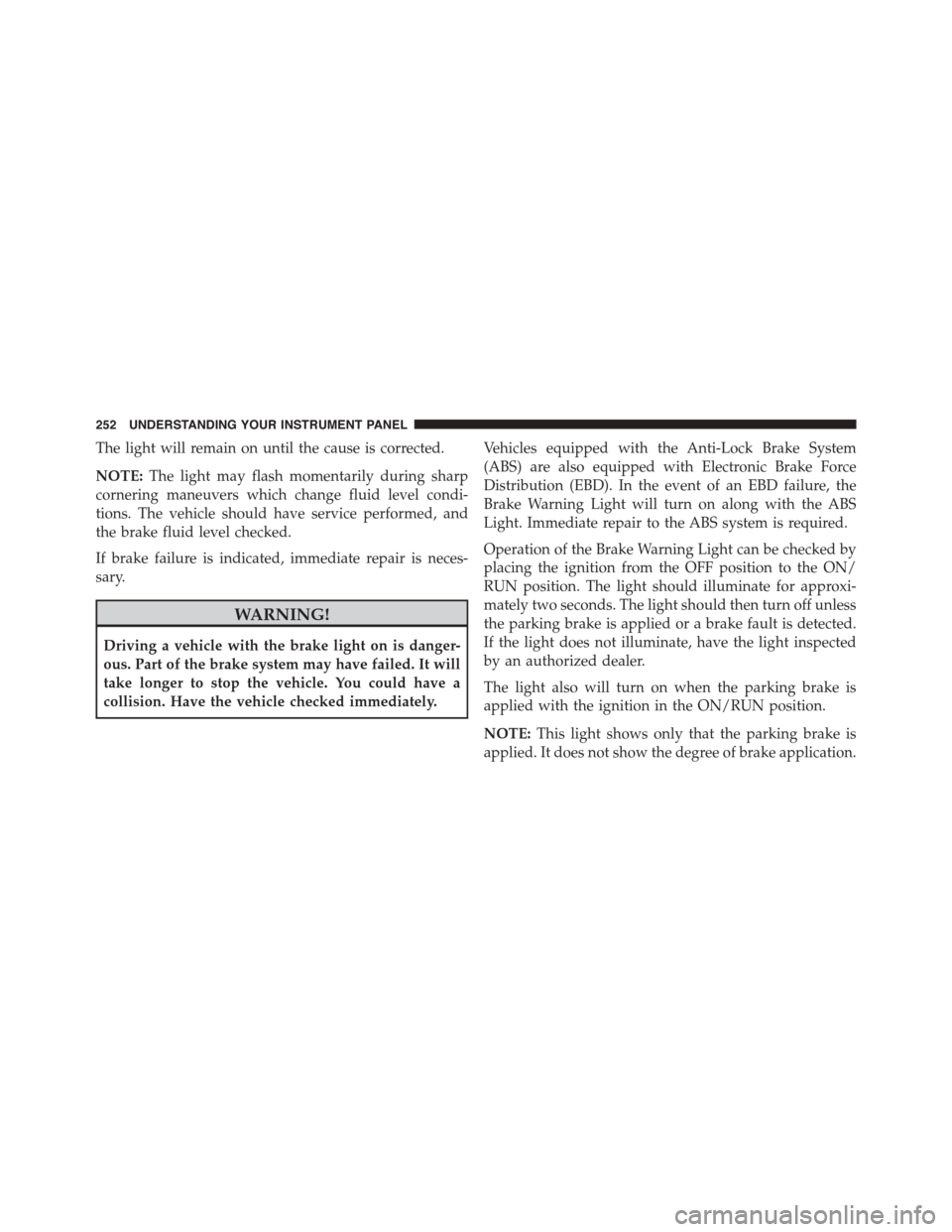
The light will remain on until the cause is corrected.
NOTE:The light may flash momentarily during sharp
cornering maneuvers which change fluid level condi-
tions. The vehicle should have service performed, and
the brake fluid level checked.
If brake failure is indicated, immediate repair is neces-
sary.
WARNING!
Driving a vehicle with the brake light on is danger-
ous. Part of the brake system may have failed. It will
take longer to stop the vehicle. You could have a
collision. Have the vehicle checked immediately.
Vehicles equipped with the Anti-Lock Brake System
(ABS) are also equipped with Electronic Brake Force
Distribution (EBD). In the event of an EBD failure, the
Brake Warning Light will turn on along with the ABS
Light. Immediate repair to the ABS system is required.
Operation of the Brake Warning Light can be checked by
placing the ignition from the OFF position to the ON/
RUN position. The light should illuminate for approxi-
mately two seconds. The light should then turn off unless
the parking brake is applied or a brake fault is detected.
If the light does not illuminate, have the light inspected
by an authorized dealer.
The light also will turn on when the parking brake is
applied with the ignition in the ON/RUN position.
NOTE:This light shows only that the parking brake is
applied. It does not show the degree of brake application.
252 UNDERSTANDING YOUR INSTRUMENT PANEL
Page 259 of 595
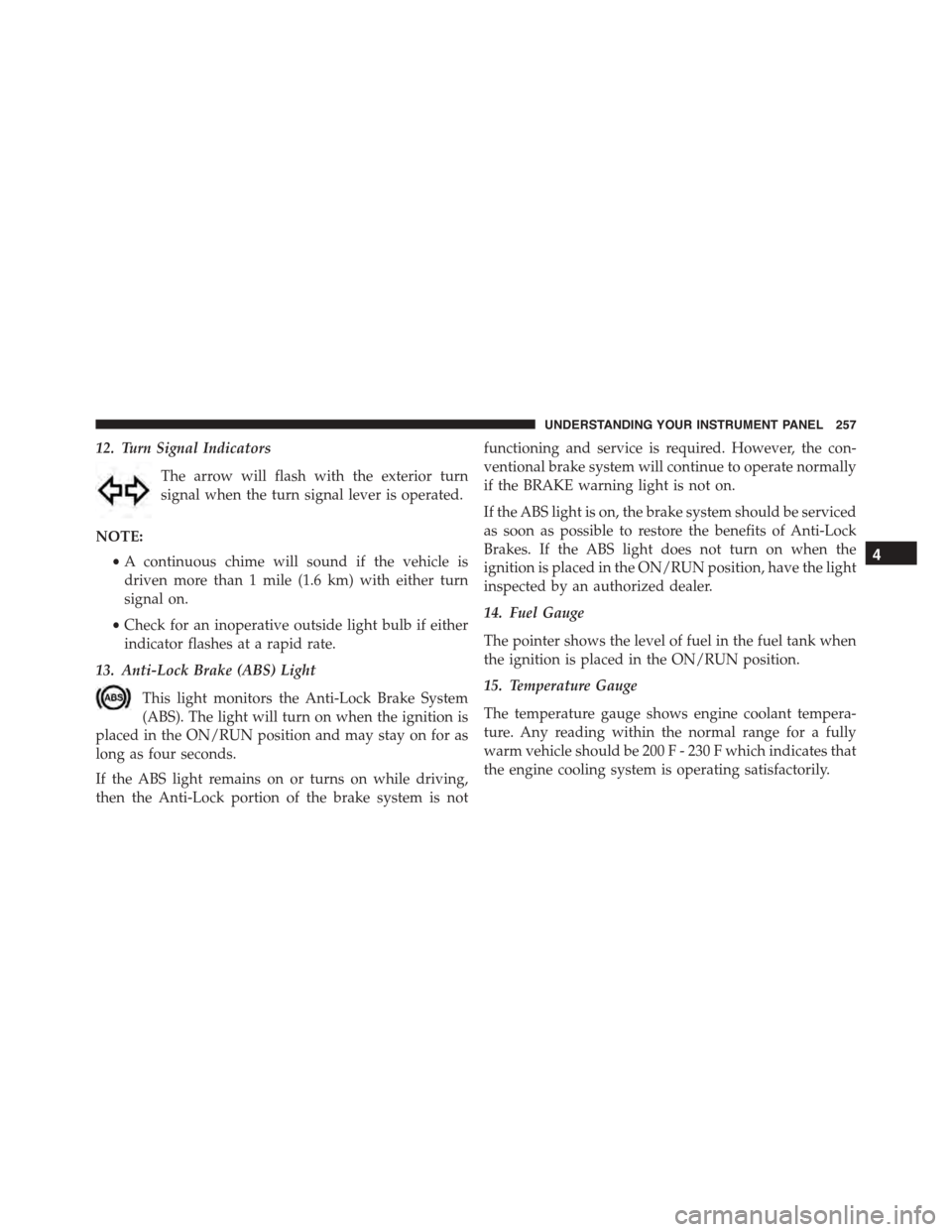
12. Turn Signal Indicators
The arrow will flash with the exterior turn
signal when the turn signal lever is operated.
NOTE:
•A continuous chime will sound if the vehicle is
driven more than 1 mile (1.6 km) with either turn
signal on.
•Check for an inoperative outside light bulb if either
indicator flashes at a rapid rate.
13. Anti-Lock Brake (ABS) Light
This light monitors the Anti-Lock Brake System
(ABS). The light will turn on when the ignition is
placed in the ON/RUN position and may stay on for as
long as four seconds.
If the ABS light remains on or turns on while driving,
then the Anti-Lock portion of the brake system is not
functioning and service is required. However, the con-
ventional brake system will continue to operate normally
if the BRAKE warning light is not on.
If the ABS light is on, the brake system should be serviced
as soon as possible to restore the benefits of Anti-Lock
Brakes. If the ABS light does not turn on when the
ignition is placed in the ON/RUN position, have the light
inspected by an authorized dealer.
14. Fuel Gauge
The pointer shows the level of fuel in the fuel tank when
the ignition is placed in the ON/RUN position.
15. Temperature Gauge
The temperature gauge shows engine coolant tempera-
ture. Any reading within the normal range for a fully
warm vehicle should be 200 F - 230 F which indicates that
the engine cooling system is operating satisfactorily.
4
UNDERSTANDING YOUR INSTRUMENT PANEL 257
Page 368 of 595
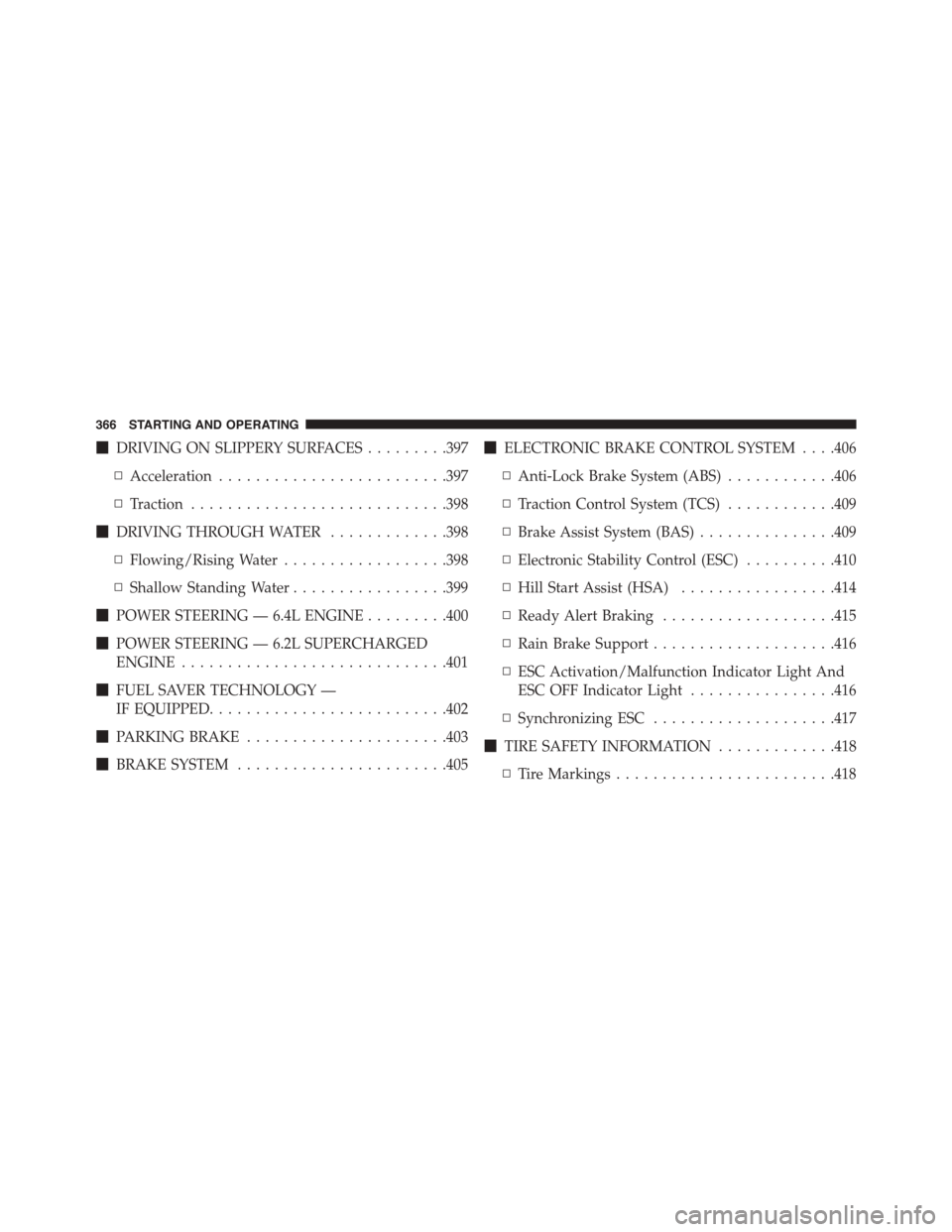
!DRIVING ON SLIPPERY SURFACES.........397
▫Acceleration.........................397
▫Traction............................398
!DRIVING THROUGH WATER.............398
▫Flowing/Rising Water..................398
▫Shallow Standing Water.................399
!POWER STEERING — 6.4L ENGINE.........400
!POWER STEERING — 6.2L SUPERCHARGED
ENGINE.............................401
!FUEL SAVER TECHNOLOGY —
IF EQUIPPED..........................402
!PARKING BRAKE......................403
!BRAKE SYSTEM.......................405
!ELECTRONIC BRAKE CONTROL SYSTEM . . . .406
▫Anti-Lock Brake System (ABS)............406
▫Traction Control System (TCS)............409
▫Brake Assist System (BAS)...............409
▫Electronic Stability Control (ESC)..........410
▫Hill Start Assist (HSA).................414
▫Ready Alert Braking...................415
▫Rain Brake Support....................416
▫ESC Activation/Malfunction Indicator Light And
ESC OFF Indicator Light................416
▫Synchronizing ESC....................417
!TIRE SAFETY INFORMATION.............418
▫Tire Markings........................418
366 STARTING AND OPERATING
Page 390 of 595
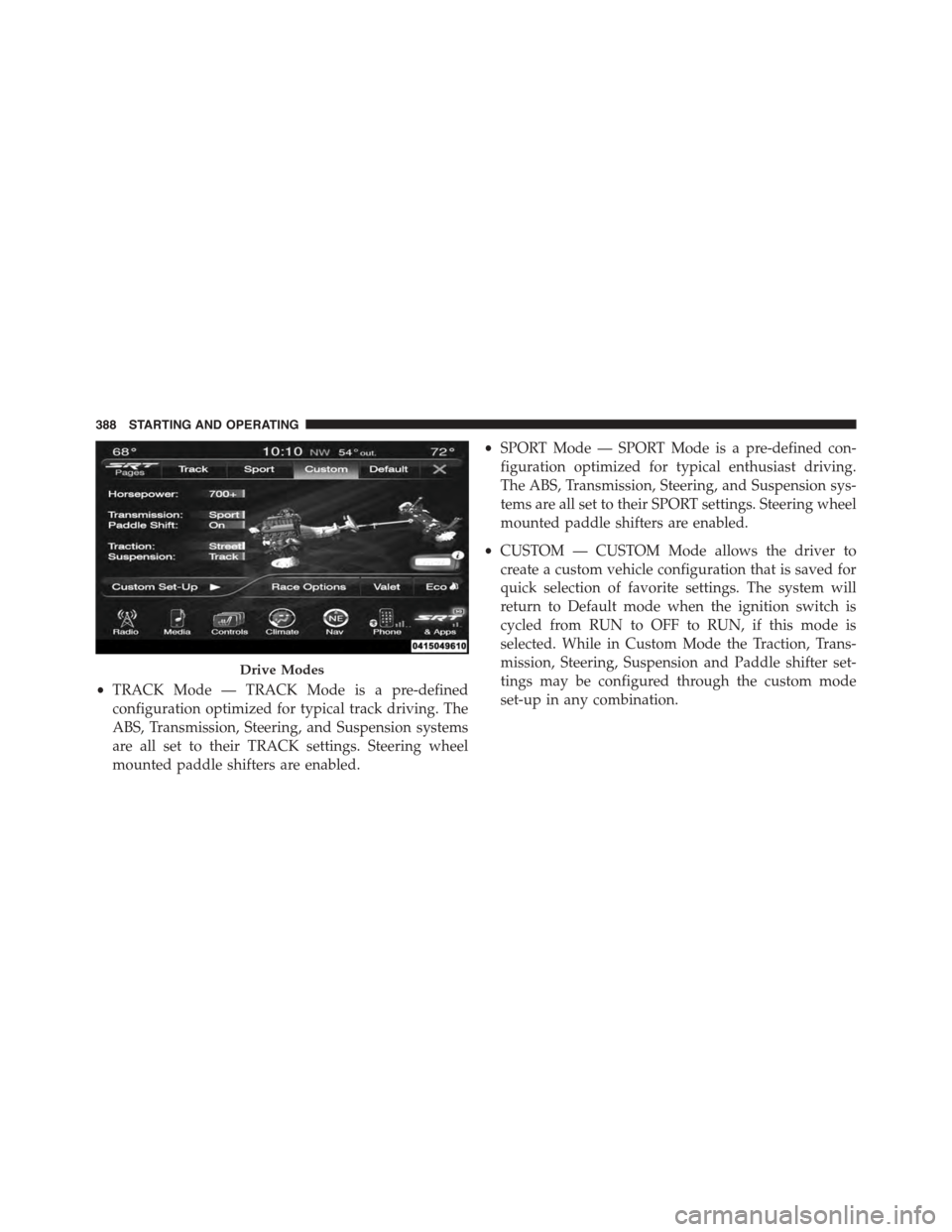
•TRACK Mode — TRACK Mode is a pre-defined
configuration optimized for typical track driving. The
ABS, Transmission, Steering, and Suspension systems
are all set to their TRACK settings. Steering wheel
mounted paddle shifters are enabled.
•SPORT Mode — SPORT Mode is a pre-defined con-
figuration optimized for typical enthusiast driving.
The ABS, Transmission, Steering, and Suspension sys-
tems are all set to their SPORT settings. Steering wheel
mounted paddle shifters are enabled.
•CUSTOM — CUSTOM Mode allows the driver to
create a custom vehicle configuration that is saved for
quick selection of favorite settings. The system will
return to Default mode when the ignition switch is
cycled from RUN to OFF to RUN, if this mode is
selected. While in Custom Mode the Traction, Trans-
mission, Steering, Suspension and Paddle shifter set-
tings may be configured through the custom mode
set-up in any combination.
Drive Modes
388 STARTING AND OPERATING
Page 392 of 595
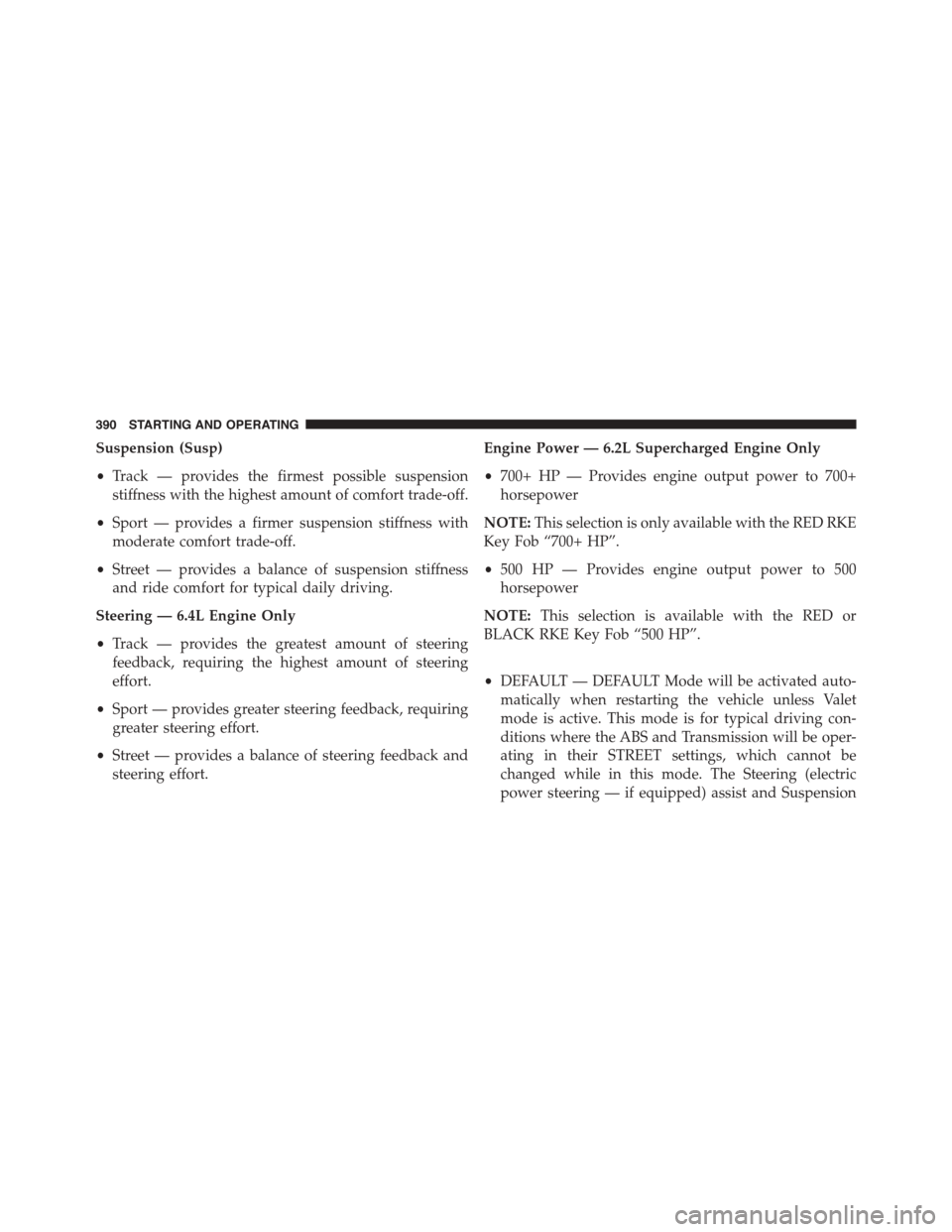
Suspension (Susp)
•Track — provides the firmest possible suspension
stiffness with the highest amount of comfort trade-off.
•Sport — provides a firmer suspension stiffness with
moderate comfort trade-off.
•Street — provides a balance of suspension stiffness
and ride comfort for typical daily driving.
Steering — 6.4L Engine Only
•Track — provides the greatest amount of steering
feedback, requiring the highest amount of steering
effort.
•Sport — provides greater steering feedback, requiring
greater steering effort.
•Street — provides a balance of steering feedback and
steering effort.
Engine Power — 6.2L Supercharged Engine Only
•700+ HP — Provides engine output power to 700+
horsepower
NOTE:This selection is only available with the RED RKE
Key Fob “700+ HP”.
•500 HP — Provides engine output power to 500
horsepower
NOTE:This selection is available with the RED or
BLACK RKE Key Fob “500 HP”.
•DEFAULT — DEFAULT Mode will be activated auto-
matically when restarting the vehicle unless Valet
mode is active. This mode is for typical driving con-
ditions where the ABS and Transmission will be oper-
ating in their STREET settings, which cannot be
changed while in this mode. The Steering (electric
power steering — if equipped) assist and Suspension
390 STARTING AND OPERATING